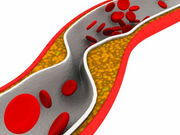Relative risk for thrombocytopenia not increased with use of citrate-buffered tirofiban
TUESDAY, Aug. 16, 2016 (HealthDay News) — For patients with acute coronary syndrome, phosphate-buffered tirofiban, but not citrate-buffered tirofiban, is associated with an increased risk of thrombocytopenia, according to a study published in the Aug. 22 issue of JACC: Cardiovascular Interventions.
Marianna Adamo, M.D., from Erasmus Medical Center in Rotterdam, Netherlands, and colleagues randomized 3,232 patients to receive tirofiban or unfractionated heparin (UFH). A total of 879 patients were allocated to phosphate-buffered tirofiban and 874 to the UFH group in the early phase, and 737 and 742 patients were treated with citrate-buffered tirofiban and UFH, respectively, in the late phase.
The researchers found that patients treated with phosphate-buffered tirofiban had an increased relative risk for thrombocytopenia in the early phase (odds ratio, 3.51 [95 percent confidence interval (CI), 1.15 to 10.73] for nadir <90,000/mm³; odds ratio, 2.83 [95 percent CI, 1.11 to 7.22] for nadir <100,000/mm³). The relative risk was not increased for patients treated with citrate-buffered tirofiban in the late phase (odds ratios, 1.01 [95 percent CI, 0.20 to 5.05] and 0.99 [95 percent CI, 0.26 to 3.45], respectively). The randomization period significantly modified the effect of the treatment on platelet decrease (P for interaction = 0.024).
“Phosphate-buffered tirofiban, currently marketed as a generic drug, is associated with a higher rate of thrombocytopenia with a potentially increased risk for adverse clinical outcomes compared with citrate-buffered tirofiban,” the authors write.
Full Text (subscription or payment may be required)
Editorial (subscription or payment may be required)
Copyright © 2016 HealthDay. All rights reserved.








